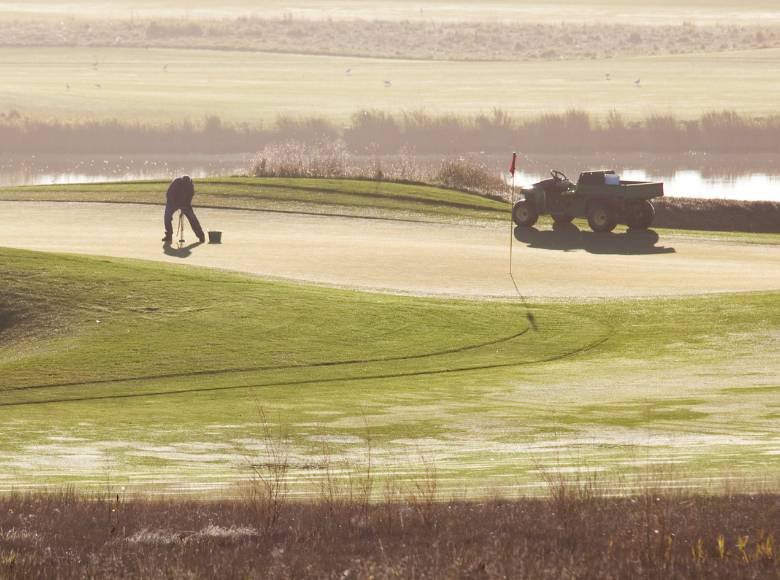The effective thatching solutions for optimal disease prevention for golf course maintenance practices involve controlled dethatching, sand topdressing, use of fertilizers, and aeration, ensuring a beautifully groomed, immediately playable, and resilient turf.
Maintaining a pristine golf course requires a keen understanding of the intricate balance between firmness, playability, and sustainable turf management. At the heart of this delicate equilibrium lies the crucial aspect of thatch management. Thatch, the layer of organic matter beneath the turf, can significantly impact the playability of the course. DTE Golf® recognizes the importance of tackling excessive thatch to ensure healthy turf growth and disease prevention.
In this blog, we’ll learn various strategies for effective thatch control.
Solutions For Effective Thatch Control
Thatch, a combination of dead and living plant matter, including roots, shoots, stems, and leaf tissues, can turn a once-firm ground into a soft and spongy surface. A thatched turf not only affects playability but also creates conditions conducive to disease, such as the development of Pythium. DTE Golf® understands that striking the right balance is crucial, with an ideal thatch layer ranging from one quarter to half an inch to maintain optimal moisture levels. If the thatch exceeds three-quarters of an inch, action must be taken.
It is important to slow organic matter production to combat thatch. Shoot and stem growth contribute significantly to thatch, and DTE Golf® recommends evaluating nitrogen inputs for controlled nutrient delivery. Liquid fertilizers, applied in a controlled manner, prevent excessive shoot growth, avoiding spikes that exacerbate the thatch problem.
DTE Golf® employs various strategies for effective thatch control:
1. Vertical Mowing or Verticutting

When it comes to golf course maintenance, the importance of vertical mowing or verticutting cannot be overstated. This intricate process serves as a linchpin for sustaining a healthy and visually appealing golf course. Utilizing specialized attachments driven by triplex greens mowers, this method stands out for its efficiency and productivity in removing excess thatch—a critical element that can compromise the overall condition of the turf.
The core of this technique lies in the precision with which it dethatches, ensuring a delicate balance between the removal of organic matter and the preservation of the turf’s integrity. Through controlled dethatching, the golf course undergoes a transformative process, emerging with a beautifully groomed surface that is not only aesthetically pleasing but also immediately playable. The result is a turf that invites golf enthusiasts to experience the game at its finest, free from the challenges posed by an overabundance of thatch.
2. Sand Topdressing
The practice of sand topdressing emerges as a transformative measure to enhance both the quality and playability of the turf. Beyond its role in smoothing the turf surface, sand topdressing plays an important role in addressing the natural voids within the turf canopy. These voids, often overlooked, can impact the overall playing experience for golf enthusiasts. Through regular applications of sand topdressing, these voids are effectively filled, culminating in a turf that not only looks immaculate but also provides an elevated and enjoyable playing surface.
One of the standout benefits of sand topdressing lies in its ability to bolster turf firmness, adding a layer of resilience that withstands the rigors of golf gameplay. This enhanced firmness not only contributes to a more consistent playing surface but also ensures that golfers experience a turf that can endure the demands of the game. As a result, sand topdressing becomes a cornerstone in the quest for golf course perfection, creating an environment where the marriage of aesthetics and functionality defines the golfing experience.
3. Fertilizers for Thatch Control
The Compost De-Thatcher, a high-quality fertilizer, utilizes slow-releasing nitrogen, soil-digesting microbes, and powerful enzymes to break down organic matter in thatch. These elements work together to maintain the right amount of thatch, ensuring overall golf course health.
4. Aeration for Thatch Control
Aeration stands as a pivotal practice in the arsenal of golf course maintenance, playing a crucial role in controlling thatch buildup. This method involves perforating the soil, creating small holes that facilitate improved airflow, water penetration, and nutrient movement.
The significance of aeration lies in its ability to disrupt and mitigate the thatch layer, preventing its excessive accumulation. By allowing essential elements like air, water, and nutrients to flow more efficiently into the grass roots, aeration contributes to a healthier and more dynamic microbial environment within the soil. Ultimately, aeration becomes a strategic maneuver to break down thatch, promoting the overall well-being and longevity of the turf on the golf course.
Effective thatching solutions are vital for disease prevention and optimal golf course maintenance. DTE Golf®’s expertise in thatch management ensures a delicate balance, providing golf enthusiasts with an unparalleled experience. To elevate your golf course maintenance, contact DTE Golf® and experience the difference in turf quality and playability.
